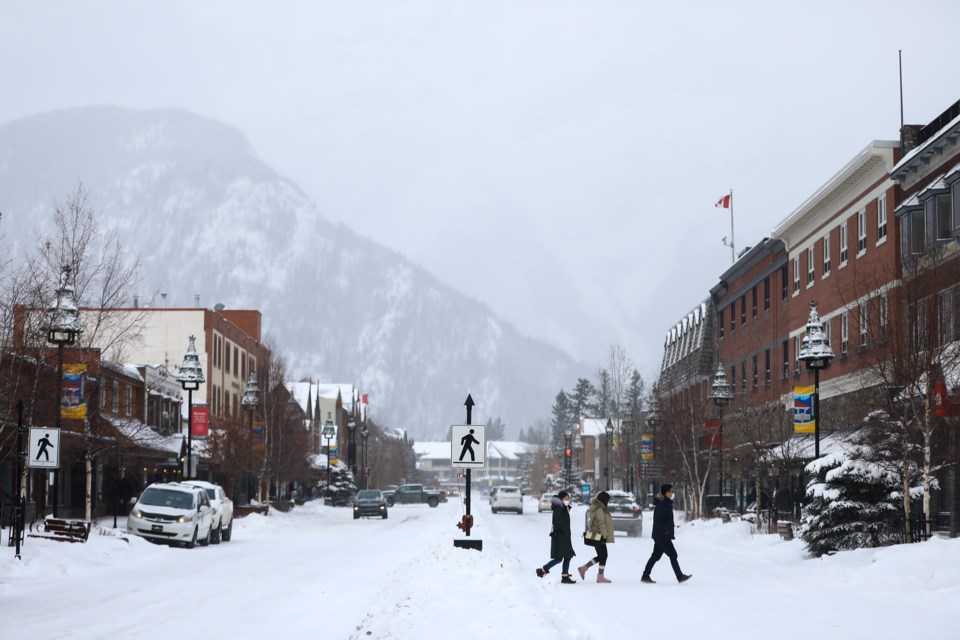BANFF – Banff’s COVID-19 cases continued to climb over the past week, prompting Banff town council to keep commercial restrictions in place for liquor and cannabis stores for at least another two weeks.
Banff and Lake Louise’s active case count was 42 as of Tuesday (Feb. 9), up from nine active cases of the virus when the region fell out of enhanced status for just one day on Jan. 25. In neighbouring Canmore, there are four active cases and 44 in the Municipal District of Bighorn, which includes parts of the Stoney Nakoda First Nation.
“I want us to continue to err on the side of caution with this. Our cases aren’t at zero, unfortunately,” said Banff Councillor Corrie DiManno during a council meeting on Monday (Feb. 8)
Banff’s second spike of COVID-19 since the pandemic began led council to vote 4-3 to extend its commercial restrictions bylaw, which was due to expire at midnight on Feb. 8, until at least Feb. 22.
This means cannabis and liquor stores must continue closing by 10 p.m., and restaurant and bars cannot sell alcohol beyond that time as part of any takeout pickup and delivery services.
Bars, restaurants and cafés, however, were allowed to reopen to in-person dining on Feb. 8 under strict conditions imposed by the Alberta government as it began its phased rollout of easing provincial restrictions.
Coun. Chip Olver said she is not yet comfortable lifting the restrictions affecting liquor and cannabis stores, noting Banff recorded 12 new active COVID-19 cases in the past week alone.
She said she might be OK with eliminating the bylaw if and when Banff had a run of one or two weeks out of enhanced status, which for Banff means fewer than 10 active cases.
“The late-night partying, after parties, social gatherings with alcohol and fewer inhibitions about staying apart are really where my concern is, and especially with all the congregate housing that we have,” Coun. Olver said.
“Let’s keep it out of there and let’s not go through this rollercoaster.”
Banff and Lake Louise have had a total of 444 people reported to have COVID-19 since the pandemic began, with 43 cases currently active.
The active case count for Banff National Park rose from 86.7 active cases per 100,000 two weeks ago to 312.2 active cases by Feb. 8.
That compared to the provincial rate of 141 and the national rate of 118 per 100,000 on the same day.
Town of Banff officials say this means Banff must remain vigilant, noting the recent spike is believed to have been linked to indoor social get-togethers as well as congregate housing in the tourist town.
Silvio Adamo, the director of emergency management for the Town of Banff, said they understand a person infected with the virus brought it into a congregate housing setting shared with other people.
“There were rumours, speculation, about social gatherings as well prior to that small jump,” he said.
“We can’t conclusively point to a specific area, but certainly that’s the intelligence that we are receiving and the assumptions we make on that information.”
Alison Gerrits, who sits on the Town of Banff’s emergency management team, said the number of cases in Banff and Lake Louise region seem to have remained steady since Feb. 2.
“The good news, I guess, is that we seemed to have levelled off, at least for now,” she said. “We’ll continue to monitor what’s happening.”
Coun. Peter Poole thanked all of the front-line workers in the community, from those working in grocery stores to doctors, nurses and EMS, for their continued hard work.
He said keeping the municipal commercial restrictions bylaw in place is a “small step to make it better for them,” reminding council that Banff’s active case count remains above the provincial and national average.
“Even if it drops to 35, that’s about six or eight times what we were comfortable with last summer,” Coun. Poole said.
“In the winter, we have more likelihood that people will be indoors and this spreads through indoor activity. This is the time to maintain this for a few weeks more.”
As of Feb. 9, there were 5,831 active cases in Alberta, with 427 people in hospital due to COVID-19, including 78 in intensive care. .
In the previous 24 hours, 12 more people died, bringing the provincial death toll from the virus to 1,722. Of those deaths, 65 per cent have been in long-term care facilities or supportive living sites.
In addition, Alberta is monitoring for variant strains of COVID-19 that have a higher infection rate. So far, the province reports 71 cases of the COVID variant first identified in the United Kingdom and seven of the South African variant have been identified in Alberta.
Adamo said talks with Alberta Health Services earlier on Monday morning indicated that there were no known cases of the variants recorded in Banff and Lake Louise.
“They have ramped up testing for the variant, but there have been, to our knowledge, none identified,” he said, noting they had been advised they would be notified if a variant strain were identified in this region.


